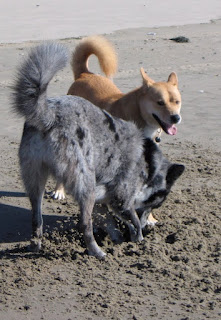 The most unexpected-- and persuasive-- outcome of my early clicker training sessions with Barley was the obvious pleasure she took from the process. She had never guessed that I could be such a source of fun. Of course, I had also suddenly become a generous dispenser of treats, but the tiny morsels of processed lamb or turkey I doled out soon became icing on the click. (Mmm. Memories of my grandmother's beagle, Bruce, whose St. Paddy's Day birthday we celebrated with towering "cakes" of marshmallow-studded Alpo.)
The most unexpected-- and persuasive-- outcome of my early clicker training sessions with Barley was the obvious pleasure she took from the process. She had never guessed that I could be such a source of fun. Of course, I had also suddenly become a generous dispenser of treats, but the tiny morsels of processed lamb or turkey I doled out soon became icing on the click. (Mmm. Memories of my grandmother's beagle, Bruce, whose St. Paddy's Day birthday we celebrated with towering "cakes" of marshmallow-studded Alpo.)Scientific study of animal behavior has only recently begun to allow for the relevance of emotional states to the process of learning. Again, this reluctance arises in part from epistemological rigor, a respect for the limits of empirical investigation and the impossibility of our directly apprehending any other creature's subjective experience-- the "black box" problem-- and in part (perhaps in the main) from a reflexive and unscientific impulse to distance ourselves from "mere beasts." I've just begun reading Jaak Panksepp's Affective Neuroscience: The Foundations of Human and Animal Emotions and its first chapter summarizes most lucidly the history of the struggle to marry psychology with neuroscience, which struggle has been made more difficult by the refusal on the part of people on both sides of the divide to acknowledge and make better scientific use of the significant overlap (the structural and functional homologies) between the brains of humans and those of their mammalian cousins.
Even if Panksepp succeeds in legitimizing the scientific description of emotion in animals, it will likely be mediated by functional MRI or its future technological offspring: "Ah, there's the blood flow pattern we'd expect to see when a dog's ears and posture perk up, its (never 'his' or 'her') mouth opens slightly, and the speed of its response accelerates!" But no algorithm, however subtle and comprehensive, will ever name "joy" as well as "joy" does. Panksepp, very much to his credit, emphasizes the importance of folding non-scientific vocabulary into scientific accounts of emotion for the sake of clarity and (strange to say) accuracy.
If science were not so grand in its claims, if its practitioners more readily acknowledged the necessary gaps in its description of reality, I would not get so resentful of the ways that "objectivity" sometimes interferes with perception, so exasperated with the willful blindness and obtuseness that characterize much scientific research, especially when sentient beings are the objects of study. As I said earlier, I only became a fan of Skinner's methods when I put them into extra-scientific, personal practice-- and thereby corrupted them. If I want to be most effective as a trainer, I need to see the animal I'm training, not as a jumble of quantifiable properties and behaviors, but as a fluidly perceiving and feeling being whose mysterious intelligence is momentarily entangled with my own.
By lucky accident or divine symmetry, all creatures appear to learn best when they enjoy the learning. If it were not so, I would reconcile myself once and for all to being a crummy trainer, just to keep Barley smiling.
No comments:
Post a Comment